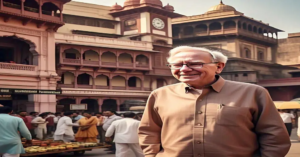Warren Buffett net worth vs Elon Musk
Warren Buffett: The Oracle of Omaha

Today I will explain Warren Buffett versus Elon Musk. There are differences in their investment perspectives. What this can teach us about investing in the world of innovation.
If you’re interested in learning how to make money in both bull and bear markets. If you want to see what I’m trading or investing in, be sure to hit that subscribe button. So, obviously, we’ve had the news that Elon Musk just surpassed Warren Buffett in terms of his net worth.
Now, some of this is because Buffett’s been giving away his money, obviously. But I thought it’d be interesting to kind of move beyond the headlines. Then, really think about how Elon Musk and Warren Buffett approach the world and investing versus Warren Buffett.
Warren Buffett is better than Elon Musk
So I would say that Musk is obviously an innovator, one of our great inventors. He’s into solving really hard problems and pushing the frontiers of human knowledge. Warren Buffett, I would argue, is the exact opposite; he likes that he developed this idea of the investment mode. Which he, I believe, got from Ben.
Graham Buffett talks about using investment modes as a way of protecting the company, ensuring that it can stifle competition and innovation, so where Musk is really moving us towards the future, Buffett has been all about preserving the status quo and sort of rent-seeking and milking an existing customer base.
Elon Musk, I love this tweet: Open your eyes; look up to the skies. One of his really, really great ones is trying to get people to Mars by 2025. He is really, really a visionary, and then on the other side, you have Buffett and the sort of role model he is always talking about, Cherry Coke, and if you look at his portfolio, it’s really shocking how much of it is addictive garbage junk food, everything from Kraft Heinz.
How did Musk make Warren Buffett rich?
So, Musk is clearly a major innovator. Now, obviously, I grew up eating all this stuff as a kid at KG. I like to eat it, but this is definitely stuff that holds humanity back. I mean, spreading Coca-Cola all over the world has made Buffett very rich.
But it’s also created a huge amount of diabetes, especially in emerging markets, and I think Buffett has this; he has this very nice public image, very grandfatherly, but when you really dig down and you see what he does and what he invests in, I think it’s—I think it’s disturbing actually. You can go back and read this; it’s a link to this.
This is a famous Charlie Munger talk where he talks about how to create a trillion-dollar company; he’s basically talking about Coca-Cola, but he talks about how you need to include sugar, caffeine, and salt and make it really addictive and have it spread all over the world.
Warren Buffett investments
You created it with no aftertaste, and so people will drink more of it. It’s brilliant. Munger’s a brilliant guy. Buffett’s a brilliant guy, but when you read this in the context of modern addiction and everything like that, it’s actually quite disturbing, so I’ll link to that.
It’s definitely worth reading, though; his Munger talks about the famous Lollapalooza effect in here on the other side of some of Buffett’s investments; he sold off some of these. He’s turned against Goldman Sachs. Buffett’s investing in the big US banks is really the opposite of innovation.
These are giant rent-seeking corporations that use their power and their government sanction to keep down rivals. This is a great meme. I don’t always go to the bank; when I do, I avoid Wells Fargo, which is sort of Buffett’s longest and most famous bank holding, perhaps.
Warren Buffett, opposite to Elon Musk

Wells Fargo has just a tremendous amount of power; here’s a recent story telling clients they need to have a million dollars in balances to do a jumbo mortgage refi. This is obviously a sign of the amount of competition that’s in this market.
Buffett has been a large holder of Moody’s, which is a bond rating agency, since before the financial crisis, and Moody’s was one of the real contributors to the great financial crisis.
Everything crashed. Buffett got in on a lot of sweetheart deals during the great financial crisis of 2008 and 2009, and he’s really famous for never having criticized Moody’s for what they did in terms of rating risky bonds.
Warren Buffett clean image
As it’s not risky, I’ll give you one simple example of a big established company: Coke, obviously an iconic Buffett holding, and their idea of innovation versus what real innovation looks like. Here’s a story from late last year: Coke is launching a new sparkling water brand called Eh-eh.
Obviously, their market share has been—Coke’s market share has been falling a lot over the last 20 years as people moved to sort of healthier beverages, but here’s Coke’s idea of innovation: sparkling water.
with caffeine, of course, to make it addictive when you compare it to all these. This real flourishing of innovative products that we have now, particularly in, I would say, probably particularly in the US, is a company called DRAM, DRAM Apothecary.
Warren Buffett – biggest stockholder
I’ve had their beverages, and they’re just amazing. Here is one that is adaptogenic: CBD sparkling water with silver ear mushroom, moringa leaf, and bilberry. Really cool stuff like this, as opposed to it, is much more difficult, especially when you have an investment.
I like this mode to really think outside the box. You’ve been so protected for so many years, and this is sort of the difference. If Eli were the head of a soda company, he would, I think, do something more like DRAM than Coke.
If you look at Buffett’s biggest stock holdings here, these are the largest. He obviously has private companies and private subsidiaries of Berkshire Hathaway, but if you just look at this, it boggles the mind if you were worth hundreds of millions or billions of dollars and you woke up in the 20th century holding things like Bank of America and Delta Airlines; he’s obviously since dumped the airlines.
Warren Buffett owns Apple and Amazon
JP Morgan, Moody’s, and US Bank Corp. are companies that have a real stranglehold, and perhaps it’s a warning for all of us that Buffett also owns Apple and Amazon.
If he didn’t, if he didn’t hope these, he would have fallen much, much further behind the SP500 than he has, but it may give you insight into Apple and Amazon’s monopoly powers. Buffett likes investing in companies that are anti-innovation and that swallow up and prevent new competitors from entering the landscape, so obviously, that includes Apple and Amazon, as we said.
likes investing in companies that are anti-innovation and that swallow up and prevent new competitors from entering the landscape, so obviously, own Apple and Amazon, as we said.
Involvement in money laundering?
I’ll link to the list of Wells Fargo scandals. The extremely long JPMorgan scandals are really long; here’s a story about how they owned a ship containing 20 tons of cocaine.
Companies implicated in money laundering for many years, laundering drug money, laundering terror terrorism money, and just not very nice companies in my opinion.
Finally, we’ll finish with Buffett on his views on money, gold, and Bitcoin, and here, he’s definitely a fan of the Fiat system. We’re very, very anti-gold. This is a famous article from Fortune from 2012 where he talks about how he likes stocks so much more than gold and bonds, and this would make sense from someone who owns so many of the big banks and is so invested in the Fiat system.
Illegal Purchase of Gold and Bitcoin?
But if you look at how Berkshire Hathaway, which is Buffett’s company, obviously is a conglomerate, his holding company, Buffett’s Berkshire Hathaway has, at this point, gold has been underperforming for most of the last 20 years; here’s the chart.
The red is gold, the actual precious metal of the commodity, and the blue line is Berkshire Hathaway. It’s quite ironic that he’s actually underperforming gold over this whole time period.
If you compare Berkshire Hathaway to Bitcoin, I probably should have used a logarithmic chart here, but you can see Bitcoin’s up something like 7,000 percent over this time horizon.
How did Buffett hurt people?
I believe I have only been going back as far as 2013 and obviously Berkshire. It’s kind of an unfair comparison because Bitcoin is very small or started off as a very small company—I mean, a very small new currency—and Berkshire Hathaway is obviously much bigger with slower growth rates.
But I just find it ironic that someone who attacks that gold and attacks Bitcoin would have just massively underperformed them and continue to underperform them. Munger is also not a fan of Bitcoin, saying that it’s disgusting that people buy Bitcoin.
Munger and Buffett are the kind of people who want you locked into the fiat system so they can continue to charge you crazy fees like Wells Fargo does, and what’s ironic is most of these bank fees obviously hurt working-class and middle-class people more than they hurt upper-class account holders.
Buffett is a dinosaur
So one of the great ironies is that I would suggest that history is probably going to judge Buffett a little bit more harshly than his contemporaries have. Here’s a great Buffett’s famous saying that I think of what Munger said: Well, the Bitcoin is rat poison, rat poison squared, and fear here.
I think Buffett really is a dinosaur. This is a great image of magic internet money, Bitcoin, as the meteor, the comet that destroyed the dinosaurs, and here we have all these legacy currencies like the Canadian dollar, the euro, the Australian dollar, and the US dollar. Then, Warren Buffett is here on the left as one of the dinosaurs.
If you found this video helpful and you really want a less superficial or fun version of it. I have a much longer video on why value investing is dead and why it has stopped working since 2009.
If you really want to dig into that and get a better idea of why this strategy has continued to underperform and should continue to underperform going forward, I’m much more, as you can tell, in the Musk camp of innovation growth stocks moving humanity forward.

